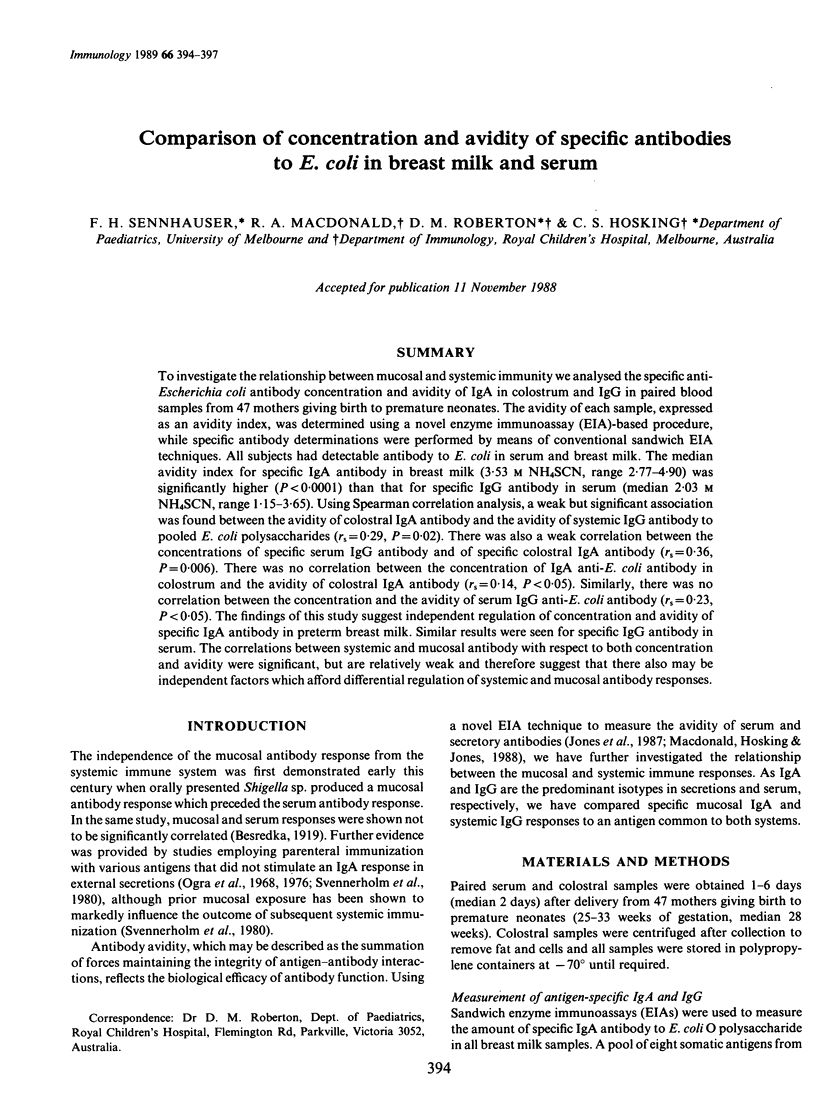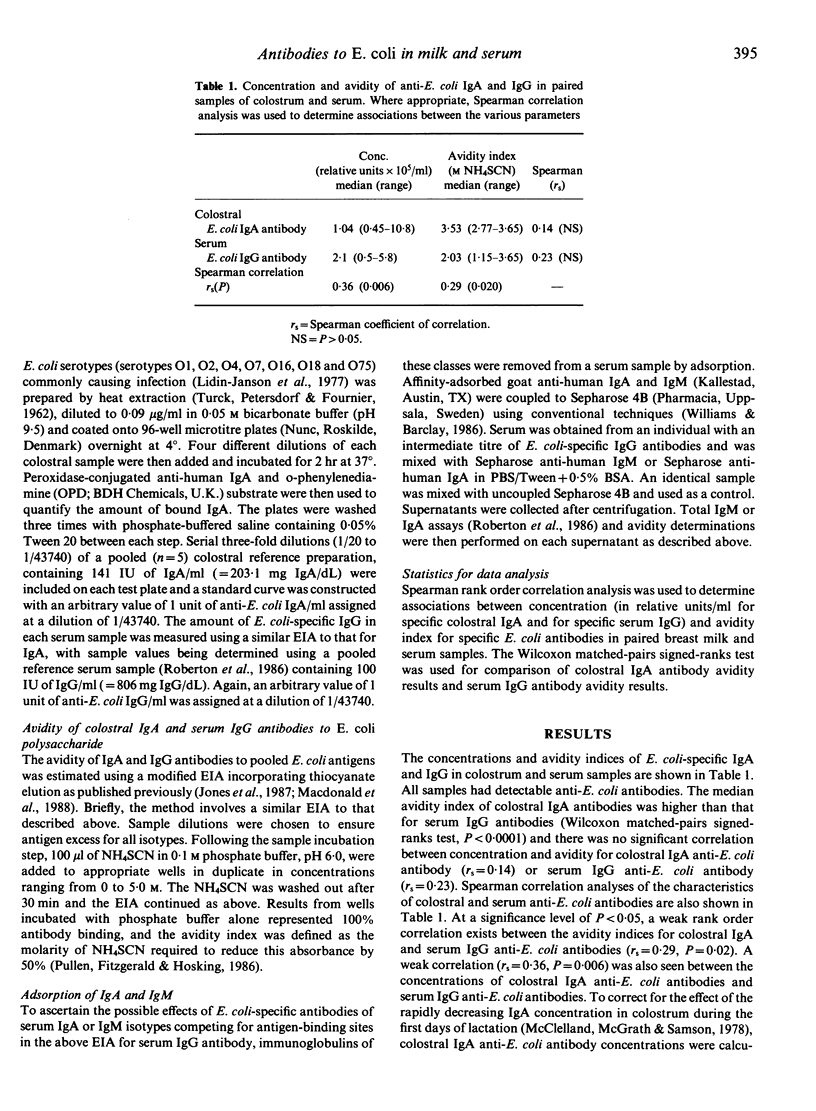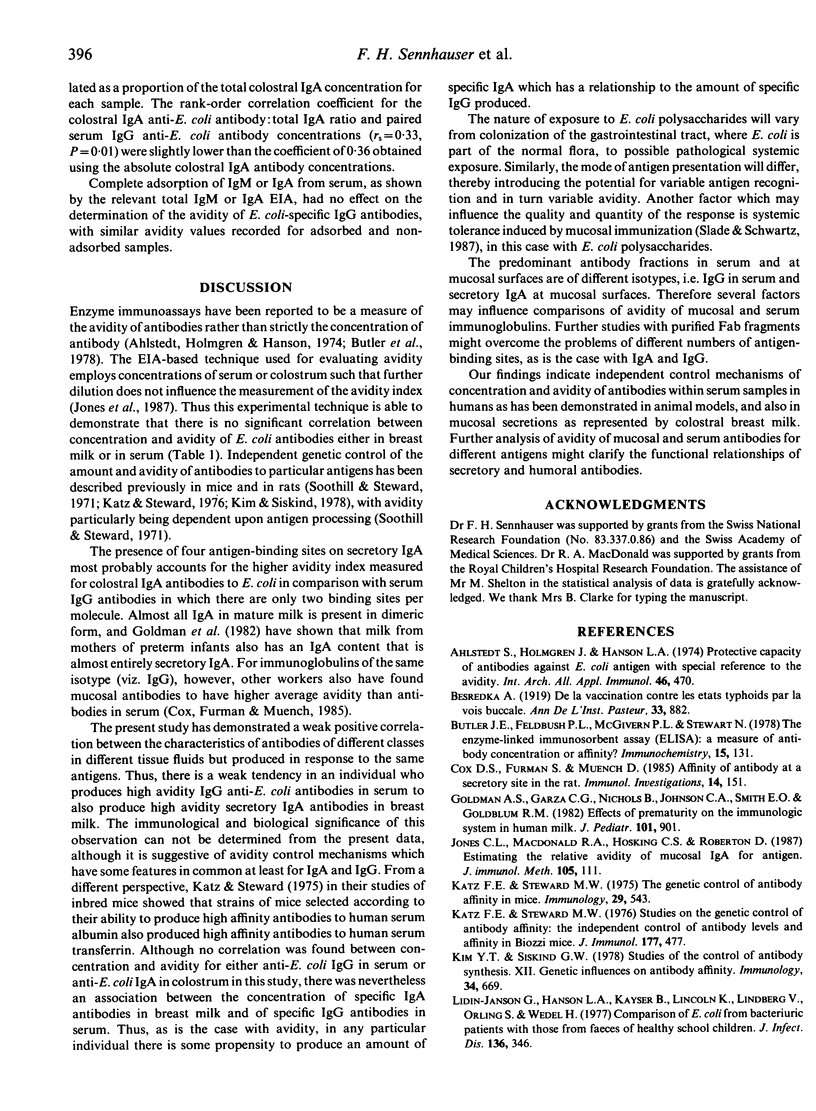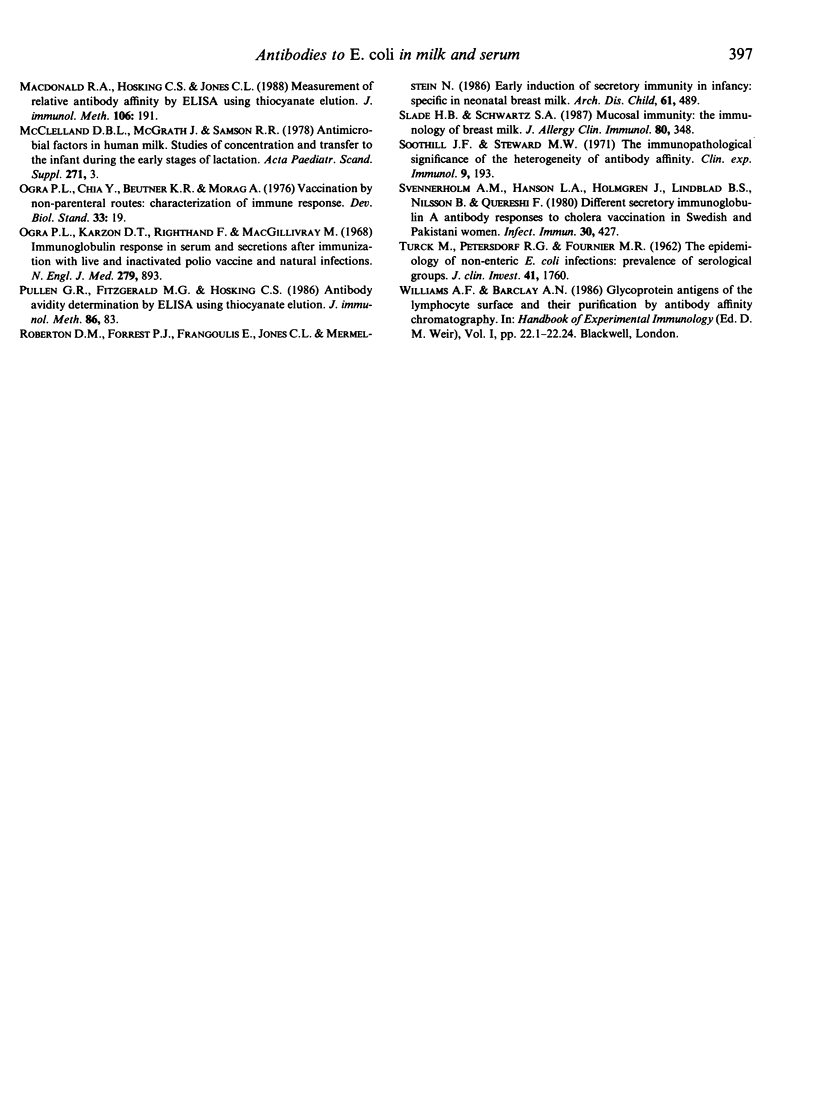Abstract
To investigate the relationship between mucosal and systemic immunity we analysed the specific anti-Escherichia coli antibody concentration and avidity of IgA in colostrum and IgG in paired blood samples from 47 mothers giving birth to premature neonates. The avidity of each sample, expressed as an avidity index, was determined using a novel enzyme immunoassay (EIA)-based procedure, while specific antibody determinations were performed by means of conventional sandwich EIA techniques. All subjects had detectable antibody to E. coli in serum and breast milk. The median avidity index for specific IgA antibody in breast milk (3.53 M NH4SCN, range 2.77-4.90) was significantly higher (P less than 0.0001) than that for specific IgG antibody in serum (median 2.03 M NH4SCN, range 1.15-3.65). Using Spearman correlation analysis, a weak but significant association was found between the avidity of colostral IgA antibody and the avidity of systemic IgG antibody to pooled E. coli polysaccharides (rs = 0.29, P = 0.02). There was also a weak correlation between the concentrations of specific serum IgG antibody and of specific colostral IgA antibody (rs = 0.36, P = 0.006). There was no correlation between the concentration of IgA anti-E. coli antibody in colostrum and the avidity of colostral IgA antibody (rs = 0.14, P less than 0.05). Similarly, there was no correlation between the concentration and the avidity of serum IgG anti-E. coli antibody (rs = 0.23, P less than 0.05). The findings of this study suggest independent regulation of concentration and avidity of specific IgA antibody in preterm breast milk. Similar results were seen for specific IgG antibody in serum. The correlations between systemic and mucosal antibody with respect to both concentration and avidity were significant, but are relatively weak and therefore suggest that there also may be independent factors which afford differential regulation of systemic and mucosal antibody responses.
Full text
PDF



Selected References
These references are in PubMed. This may not be the complete list of references from this article.
- Ahlstedt S., Holmgren J., Hanson L. A. Protective capacity of antibodies against E. coli O antigen with special reference to the avidity. Int Arch Allergy Appl Immunol. 1974;46(3):470–480. doi: 10.1159/000231150. [DOI] [PubMed] [Google Scholar]
- Butler J. E., Feldbush T. L., McGivern P. L., Stewart N. The enzyme-linked immunosorbent assay (ELISA): a measure of antibody concentration or affinity. Immunochemistry. 1978 Feb;15(2):131–136. doi: 10.1016/0161-5890(78)90053-6. [DOI] [PubMed] [Google Scholar]
- Cox D. S., Furman S., Muench D. Affinity of antibody at a secretory site in the rat. Immunol Invest. 1985 Apr;14(2):151–159. doi: 10.3109/08820138509042009. [DOI] [PubMed] [Google Scholar]
- Goldman A. S., Garza C., Nichols B., Johnson C. A., Smith E. O., Goldblum R. M. Effects of prematurity on the immunologic system in human milk. J Pediatr. 1982 Dec;101(6):901–905. doi: 10.1016/s0022-3476(82)80007-3. [DOI] [PubMed] [Google Scholar]
- Jones C. L., Macdonald R. A., Hosking C. S., Roberton D. M. Estimating the relative avidity of mucosal IgA for antigen. J Immunol Methods. 1987 Dec 4;105(1):111–117. doi: 10.1016/0022-1759(87)90420-0. [DOI] [PubMed] [Google Scholar]
- Katz F. E., Steward M. W. Studies on the genetic control of antibody affinity: the independent control of antibody levels and affinity in Biozzi mice. J Immunol. 1976 Aug;117(2):477–479. [PubMed] [Google Scholar]
- Katz F. E., Steward M. W. The genetic control of antibody affinity in mice. Immunology. 1975 Sep;29(3):543–548. [PMC free article] [PubMed] [Google Scholar]
- Kim Y. T., Siskind G. W. Studies on the control of antibody synthesis. XII. Genetic influences on antibody affinity. Immunology. 1978 Apr;34(4):669–678. [PMC free article] [PubMed] [Google Scholar]
- Lidin-Janson G., Hanson L. A., Kaijser B., Lincoln K., Lindberg U., Olling S., Wedel H. Comparison of Escherichia coli from bacteriuric patients with those from feces of healthy schoolchildren. J Infect Dis. 1977 Sep;136(3):346–353. doi: 10.1093/infdis/136.3.346. [DOI] [PubMed] [Google Scholar]
- Macdonald R. A., Hosking C. S., Jones C. L. The measurement of relative antibody affinity by ELISA using thiocyanate elution. J Immunol Methods. 1988 Feb 10;106(2):191–194. doi: 10.1016/0022-1759(88)90196-2. [DOI] [PubMed] [Google Scholar]
- Pullen G. R., Fitzgerald M. G., Hosking C. S. Antibody avidity determination by ELISA using thiocyanate elution. J Immunol Methods. 1986 Jan 22;86(1):83–87. doi: 10.1016/0022-1759(86)90268-1. [DOI] [PubMed] [Google Scholar]
- Roberton D. M., Forrest P. J., Frangoulis E., Jones C. L., Mermelstein N. Early induction of secretory immunity in infancy: specific antibody in neonatal breast milk. Arch Dis Child. 1986 May;61(5):489–494. doi: 10.1136/adc.61.5.489. [DOI] [PMC free article] [PubMed] [Google Scholar]
- Slade H. B., Schwartz S. A. Mucosal immunity: the immunology of breast milk. J Allergy Clin Immunol. 1987 Sep;80(3 Pt 1):348–358. doi: 10.1016/0091-6749(87)90041-8. [DOI] [PMC free article] [PubMed] [Google Scholar]
- Soothill J. F., Steward M. W. The immunopathological significance of the heterogeneity of antibody affinity. Clin Exp Immunol. 1971 Aug;9(2):193–199. [PMC free article] [PubMed] [Google Scholar]
- Svennerholm A. M., Hanson L. A., Holmgren J., Lindblad B. S., Nilsson B., Quereshi F. Different secretory immunoglobulin A antibody responses to cholera vaccination in Swedish and Pakistani women. Infect Immun. 1980 Nov;30(2):427–430. doi: 10.1128/iai.30.2.427-430.1980. [DOI] [PMC free article] [PubMed] [Google Scholar]
- TURCK M., PETERSDORF R. G. The epidemiology of nonenteric Escherichia coli infections: prevalence of serological groups. J Clin Invest. 1962 Sep;41:1760–1765. doi: 10.1172/JCI104635. [DOI] [PMC free article] [PubMed] [Google Scholar]


